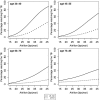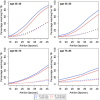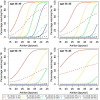Telomeres and the natural lifespan limit in humans
- PMID: 28394764
- PMCID: PMC5425118
- DOI: 10.18632/aging.101216
Telomeres and the natural lifespan limit in humans
Abstract
An ongoing debate in demography has focused on whether the human lifespan has a maximal natural limit. Taking a mechanistic perspective, and knowing that short telomeres are associated with diminished longevity, we examined whether telomere length dynamics during adult life could set a maximal natural lifespan limit. We define leukocyte telomere length of 5 kb as the 'telomeric brink', which denotes a high risk of imminent death. We show that a subset of adults may reach the telomeric brink within the current life expectancy and more so for a 100-year life expectancy. Thus, secular trends in life expectancy should confront a biological limit due to crossing the telomeric brink.
Keywords: leukocytes; life-expectancy; longevity; maximal lifespan; sex.
Conflict of interest statement
Figures




Similar articles
-
Tying it all together: telomeres, sexual size dimorphism and the gender gap in life expectancy.Med Hypotheses. 2004;62(1):151-4. doi: 10.1016/s0306-9877(03)00316-5. Med Hypotheses. 2004. PMID: 14729022
-
The rate of telomere loss is related to maximum lifespan in birds.Philos Trans R Soc Lond B Biol Sci. 2018 Mar 5;373(1741):20160445. doi: 10.1098/rstb.2016.0445. Philos Trans R Soc Lond B Biol Sci. 2018. PMID: 29335369 Free PMC article.
-
Leukocytes of exceptionally old persons display ultra-short telomeres.Am J Physiol Regul Integr Comp Physiol. 2007 Dec;293(6):R2210-7. doi: 10.1152/ajpregu.00615.2007. Epub 2007 Sep 26. Am J Physiol Regul Integr Comp Physiol. 2007. PMID: 17898116
-
Telomeres and their role in aging and longevity.Curr Vasc Pharmacol. 2014;12(5):726-34. doi: 10.2174/1570161111666131219112946. Curr Vasc Pharmacol. 2014. PMID: 24350925 Review.
-
Sex differences in telomeres and lifespan.Aging Cell. 2011 Dec;10(6):913-21. doi: 10.1111/j.1474-9726.2011.00741.x. Epub 2011 Sep 28. Aging Cell. 2011. PMID: 21902801 Review.
Cited by
-
Searching for Beauty and Health: Aging in Women, Nutrition, and the Secret in Telomeres.Nutrients. 2024 Sep 15;16(18):3111. doi: 10.3390/nu16183111. Nutrients. 2024. PMID: 39339711 Free PMC article. Review.
-
Telomere Length Calibration from qPCR Measurement: Limitations of Current Method.Cells. 2018 Oct 24;7(11):183. doi: 10.3390/cells7110183. Cells. 2018. PMID: 30352968 Free PMC article.
-
Telomere integrated scoring system of myelodysplastic syndrome.J Clin Lab Anal. 2023 Feb;37(3):e24839. doi: 10.1002/jcla.24839. Epub 2023 Jan 19. J Clin Lab Anal. 2023. PMID: 36658792 Free PMC article.
-
The "telomereless" erythrocytes and telomere-length dependent erythropoiesis.Aging Cell. 2023 Dec;22(12):e13997. doi: 10.1111/acel.13997. Epub 2023 Oct 12. Aging Cell. 2023. PMID: 37824094 Free PMC article.
-
Evolution of telomere maintenance and tumour suppressor mechanisms across mammals.Philos Trans R Soc Lond B Biol Sci. 2018 Mar 5;373(1741):20160443. doi: 10.1098/rstb.2016.0443. Philos Trans R Soc Lond B Biol Sci. 2018. PMID: 29335367 Free PMC article.
References
-
- Kochanek KD, Xu J, Murphy SL, Miniño AM, Kung HC. Deaths: preliminary data for 2009. Natl Vital Stat Rep. 2011; 59:1–51. - PubMed
Publication types
MeSH terms
Grants and funding
- U10 HL054509/HL/NHLBI NIH HHS/United States
- R56 AG020098/AG/NIA NIH HHS/United States
- R01 HL087652/HL/NHLBI NIH HHS/United States
- P30 AG034424/AG/NIA NIH HHS/United States
- R01 HL105756/HL/NHLBI NIH HHS/United States
- P30 DK063491/DK/NIDDK NIH HHS/United States
- N01 HC055222/HL/NHLBI NIH HHS/United States
- N01 HC085079/HL/NHLBI NIH HHS/United States
- R01 HL080295/HL/NHLBI NIH HHS/United States
- U10 HL054472/HL/NHLBI NIH HHS/United States
- U01 HL054472/HL/NHLBI NIH HHS/United States
- U01 HL054471/HL/NHLBI NIH HHS/United States
- U01 HL054496/HL/NHLBI NIH HHS/United States
- R01 HL116446/HL/NHLBI NIH HHS/United States
- R01 AG015928/AG/NIA NIH HHS/United States
- U01 HL080295/HL/NHLBI NIH HHS/United States
- N01 HC015103/HC/NHLBI NIH HHS/United States
- N01 HC085086/HL/NHLBI NIH HHS/United States
- U01 HL054509/HL/NHLBI NIH HHS/United States
- R01 AG016592/AG/NIA NIH HHS/United States
- R01 ES021724/ES/NIEHS NIH HHS/United States
- UL1 TR000124/TR/NCATS NIH HHS/United States
- R01 HL080698/HL/NHLBI NIH HHS/United States
- HHSN268201200036C/HL/NHLBI NIH HHS/United States
- N01 HC025195/HL/NHLBI NIH HHS/United States
- R01 HD071180/HD/NICHD NIH HHS/United States
- R01 AG020098/AG/NIA NIH HHS/United States
- WT_/Wellcome Trust/United Kingdom
- U10 HL054473/HL/NHLBI NIH HHS/United States
- U10 HL054495/HL/NHLBI NIH HHS/United States
- U10 HL054496/HL/NHLBI NIH HHS/United States
- U10 HL054471/HL/NHLBI NIH HHS/United States
- N01 HC075150/HL/NHLBI NIH HHS/United States
- R01 AG023629/AG/NIA NIH HHS/United States
- R01 AG027058/AG/NIA NIH HHS/United States
- N01 HC045133/HC/NHLBI NIH HHS/United States
- U01 HL054495/HL/NHLBI NIH HHS/United States
- N01 HC035129/HC/NHLBI NIH HHS/United States
- R56 AG023629/AG/NIA NIH HHS/United States
- R01 HL055673/HL/NHLBI NIH HHS/United States
- U01 HL054473/HL/NHLBI NIH HHS/United States
LinkOut - more resources
Full Text Sources
Other Literature Sources

